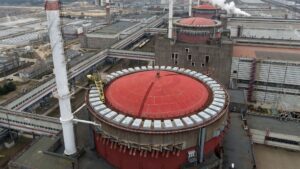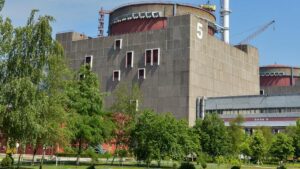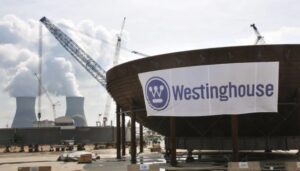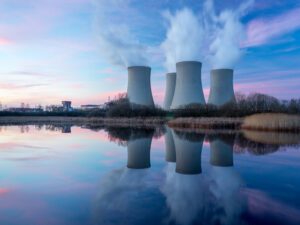
NNEGC “Energoatom” refuted the information about a fire at the second power unit of the Zaporozhye NPP, circulated in Telegram channels about an hour ago.
“We officially inform you that this is not true. As of 15:40 on September 29, 2022, no fires and fires were recorded at the power units of the Zaporozhye NPP,” the company wrote on its Telegram channel on Thursday.

NNEGC Energoatom, in a comment to the Interfax-Ukraine agency, did not confirm the information that appeared in the Telegram channels about the fire at power unit No. 2 of the Zaporozhye nuclear power plant (ZNPP).
“We are preparing a refutation,” the company said.
As reported, a number of Telegram channels reported a few minutes ago about an emergency situation at the ZNPP – a fire at unit No. 2.

Power unit No. 5 of the Zaporizhzhya NPP, which was shut down in an emergency on September 1, is back in operation, Energoatom reported.
“Today, September 2, 2022, the 5th power unit of the Zaporizhzhya NPP, which was turned off on September 1 in the morning as a result of another mortar attack by the Russian occupation forces at the ZNPP site, was connected to the power grid at 13:10,” Energoatom’s Telegram channel reported. on Friday.
According to the report, the increase in power continues.
“The station has two power units (No. 5, 6 – ER), which produce electricity for the needs of Ukraine. There are no comments on the operation of equipment and security systems,” the company said.

President of the state enterprise NNEGC Energoatom Petr Kotin said that the company is preparing for corporatization and that the Ukrainian government has already submitted the relevant draft law on the specifics of the formation of the National Nuclear Energy Generating Company Energoatom to the Parliament.
As reported in the Energoatom Telegram channel, he informed the ambassadors of the G7 countries and other officials of foreign diplomatic missions about this during a meeting in Kyiv on Wednesday, August 24.
In addition, Kotin outlined plans for the development of Energoatom and the state of implementation of joint projects with the American company Westinghouse.
“We have put an end to any dependence on Russia, first of all, it concerns the rejection of its nuclear fuel, technologies, services and components. At the same time, we are strengthening cooperation with our long-term partner Westinghouse: we will purchase nuclear fuel for all Ukrainian nuclear power plants and build 9 new power units based on AP1000 technology,” he said.
As reported, in September 2021, Energoatom and Westinghouse signed a memorandum on the construction of five nuclear power units in Ukraine. At the beginning of June 2022, the companies signed agreements to increase the number of nuclear power units to be built using AP 1000 technology in Ukraine from five to nine units, and to establish the Westinghouse Engineering and Technology Center in the country.
Energoatom is the operator of all four operating nuclear power plants in Ukraine. Operates Zaporozhye, South-Ukrainian, Rivne and Khmelnytsky stations with 15 power units equipped with water-cooled power reactors, with a total installed electrical capacity of 13.8 GW.

Energoatom and American Westinghouse are launching an internship program for Ukrainian nuclear scientists in the United States, within which more than 60 specialists and graduates of nuclear specialties will study AP1000® technology.
“Westinghouse Electric and Energoatom announced today a partnership, thanks to which more than 60 Ukrainian nuclear scientists and senior students will be able to take internships and get opportunities for development,” the company said on the Telegram channel on Wednesday.
The multi-year hands-on AP1000® technology training program will begin in the fall of 2022 at Westinghouse’s US headquarters. Upon completion of the training course, newly minted AP1000® technology technicians will have numerous opportunities to apply their engineering, technical and process support skills to new unit construction projects using this technology in Ukraine, in particular at the newly established Westinghouse Engineering and Technology Center in Kyiv, Energoatom said.
Specialists will also be trained to provide critical support for future decommissioning programs at Ukrainian nuclear power plants, the company added.
According to Oleh Boyaryntsev, Executive Director for Human Resources at Energoatom, the most talented and promising young professionals and graduates of leading Ukrainian universities will be selected for the internship.
“Thanks to the Westinghouse training program, Ukrainian specialists and students will receive a unique experience for development in the nuclear industry as we begin to implement AP1000® projects throughout Ukraine,” David Durham, president of Westinghouse Energy Systems, is quoted in the message.
He stressed that the opening of Westinghouse facilities for current and future Ukrainian nuclear scientists strengthens the company’s close partnership with Energoatom and Ukraine.
As reported, in June 2022, Westinghouse and Energoatom expanded agreements for the supply of nuclear fuel for all operating Ukrainian nuclear power plants and construction of nine AP1000® power units.

SE NNEGC Energoatom is ready to put into operation all 15 power units of 4 Ukrainian nuclear power plants next winter, company president Petr Kotin said on Ukrainian radio on Wednesday.
“We are ready to launch all 15 power units from the Energoatom generation side,” Kotin said.
At the same time, he explained that the largest in Ukraine and occupied by Russian invaders, the Zaporozhye nuclear power plant, is currently operating at half capacity due to damage to power lines.
“Everything will depend on the end of hostilities. If we liberate the Zaporozhye nuclear power plant and resume the operation of the damaged lines, then we will be able to work with all six power units at the ZNPP,” the head of Energoatom said.
At the same time, according to him, the remaining nine power units in the territory controlled by Ukraine will be ready to operate at full capacity.
“We are optimistic about these events and the fact that we will pass the heating season,” the president of NAEK stressed.
As reported, Energoatom used the practice of operating 15 power units in January-February this year, which caused ambiguous comments from experts regarding the optimal loading of the energy system in terms of the structure of generating capacities.
However, in the upcoming heating season 2022-23. The launch of the maximum number of NPP power units can be facilitated by an increase in electricity exports to the EU countries by the end of 2022 to approximately 1,000 MW.